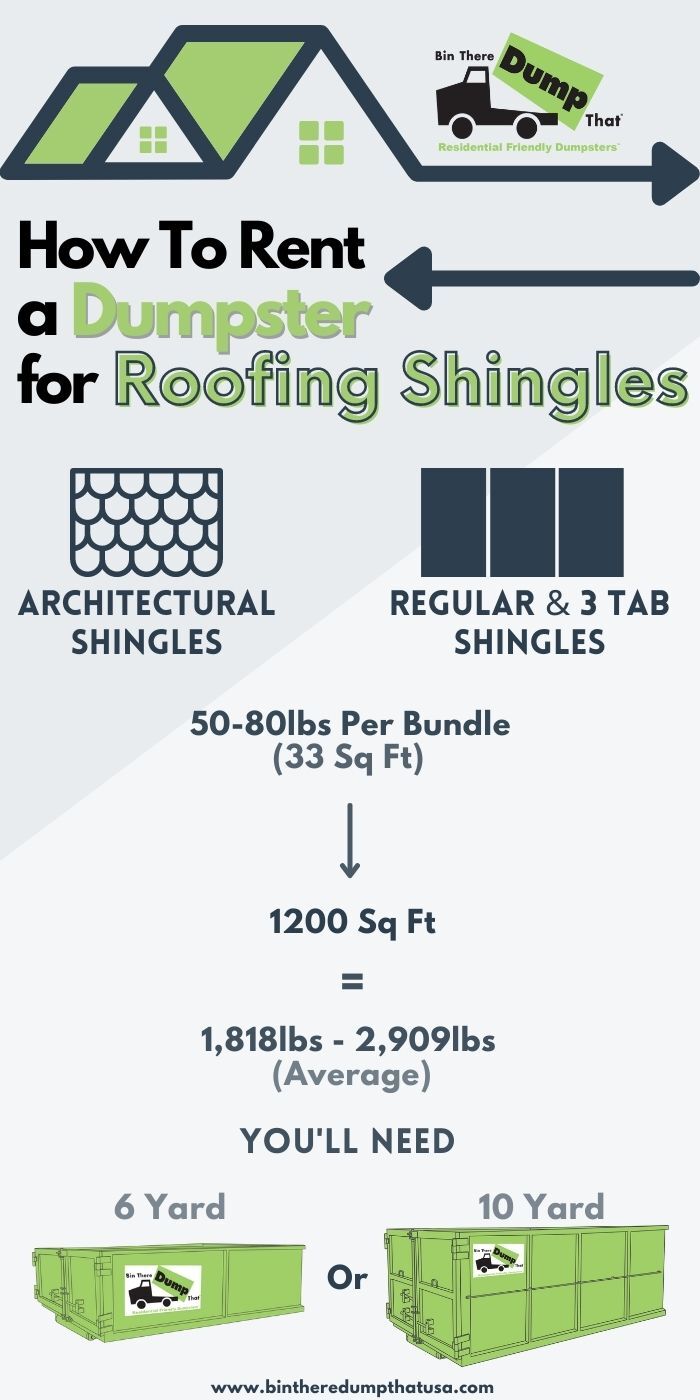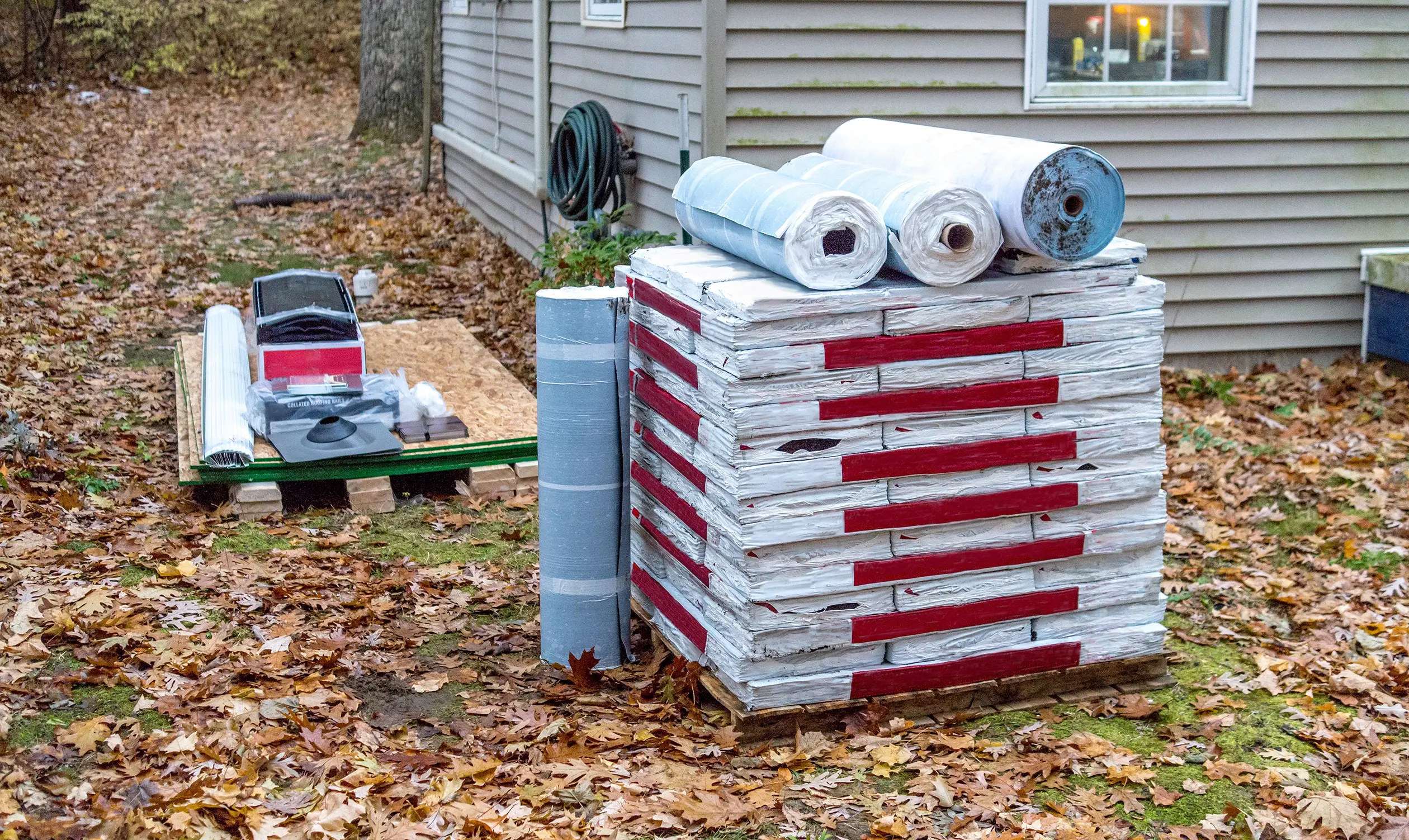Imagine standing in your local hardware store, ready to embark on that long-awaited roofing project. You’re staring at stacks of shingles, wondering how much each bag weighs and how that might impact your plans.
Knowing the weight of a bag of shingles is crucial—it affects how you transport them, how your roof supports them, and even how you budget for your project. You might be curious about whether a heavier bag means more durability, or perhaps you’re concerned about handling the weight safely.
You’ll discover the typical weight of a bag of shingles and why this information is essential for both DIY enthusiasts and professionals. By the end, you’ll feel confident and informed, ready to tackle your roofing project with ease. Dive in to uncover everything you need to know about shingle weight, and transform your project into a success story.

Credit: www.bintheredumpthat.com
Types Of Shingles
Shingles come in various types, including asphalt, wood, and metal. Each type varies in weight, but a typical bag of asphalt shingles weighs around 70 to 80 pounds. Understanding the weight helps in planning transportation and installation.
When it comes to choosing shingles for your roof, you might find yourself overwhelmed with the options. Different types of shingles offer unique benefits, weights, and styles. Understanding these differences can help you make the best choice for your home. So, let’s dive into the types of shingles, focusing on their weight and characteristics.Asphalt Shingles
Asphalt shingles are the most popular choice in the United States. They are affordable and versatile, making them a favorite among homeowners. You can expect a bundle of asphalt shingles to weigh around 60 to 80 pounds. This makes them manageable for DIY projects. However, consider the weight when planning transportation or handling. These shingles come in various colors and styles, allowing you to match your home’s aesthetic. Have you ever thought about the impact of color on your home’s curb appeal?Wood Shingles
Wood shingles bring a natural, rustic look to your home. They are often made from cedar, redwood, or pine. A bundle of wood shingles typically weighs between 100 to 200 pounds. While heavier than asphalt, they provide excellent insulation. But remember, wood shingles require more maintenance. Are you ready to invest time in preserving their charm?Metal Shingles
Metal shingles are gaining popularity for their durability. They can mimic the look of other materials while offering superior longevity. Their weight varies, with a bundle ranging from 50 to 100 pounds. This makes them lighter than wood shingles, yet they offer robust protection. Consider metal if you live in an area prone to extreme weather. Do you prioritize durability over initial cost?Slate Shingles
Slate shingles are the premium choice for those seeking elegance and longevity. They’re often seen on historic or high-end homes. A bundle of slate shingles can weigh a hefty 800 to 1,000 pounds. This weight requires professional installation and a strong roof structure. While expensive, they can last over a century. Are you prepared to invest in a roof that stands the test of time? Choosing the right shingles involves weighing factors like cost, aesthetics, and longevity. What matters most to you in your roofing decision?
Credit: wasteremovalusa.com
Factors Affecting Weight
Understanding how much a bag of shingles weighs involves several factors. These factors include material composition, size and thickness, and moisture content. Each aspect plays a vital role in determining the overall weight of the shingles. Knowing these factors helps in planning for transportation and installation.
Material Composition
Shingles are made from various materials. Common materials include asphalt, wood, and metal. Asphalt shingles are often heavier than wood shingles. Metal shingles, though lightweight, vary based on metal type. The material affects the overall weight significantly.
Shingle Size And Thickness
Size and thickness matter in shingle weight. Larger shingles weigh more than smaller ones. Thickness also adds to the weight. Thicker shingles provide better durability. But they increase the total weight per bag. Size and thickness choices impact handling and installation.
Moisture Content
Moisture in shingles affects their weight. Shingles absorb moisture from rain or humidity. Wet shingles are heavier than dry ones. Proper storage helps in maintaining low moisture levels. This reduces the weight and eases transportation.
Average Weight Of Shingles
The average weight of shingles varies greatly. It depends on the material used. Homeowners often wonder about the weight of roofing shingles. Understanding this helps in planning transport and installation. Different materials have different weights. This affects handling and installation ease. Let’s explore the average weight for various types of shingles.
Asphalt Shingles Weight
Asphalt shingles are common in residential roofing. A bundle typically weighs 50 to 80 pounds. This weight varies with thickness and style. Heavier shingles might offer more durability. They could require extra support during installation.
Wood Shingles Weight
Wood shingles offer a natural look. They usually weigh between 200 to 400 pounds per square. This weight depends on wood type and thickness. Cedar is lighter than oak. Consider the weight when planning roof support.
Metal Shingles Weight
Metal shingles are lighter than many expect. They weigh around 50 to 150 pounds per square. The weight depends on metal type and thickness. Aluminum shingles are lighter than steel ones. Their lightweight nature simplifies installation.
Slate Shingles Weight
Slate shingles are quite heavy. They can weigh up to 800 pounds per square. This weight requires strong support structures. Slate offers durability and a classic look. Ensure proper structural support for these heavy shingles.

Credit: discountdumpsterco.com
Calculating Shingle Weight
Understanding shingle weight helps in planning your roofing project. It ensures proper handling and installation. Knowing the weight also aids in estimating transportation costs. Let’s break down the components of shingle weight.
Weight Per Bundle
Shingles are usually sold in bundles. Each bundle weighs between 50 to 80 pounds. The weight varies based on the shingle type and brand. Three-tab shingles weigh less than architectural ones. Always check the manufacturer’s specifications for exact weight.
Weight Per Square
Roofers often use “square” to measure roofing area. One square equals 100 square feet. Shingles needed for a square weigh about 150 to 240 pounds. The weight depends on material and shingle type. Heavier shingles may offer more durability.
Influence Of Roofing Design
Roofing design affects the total shingle weight. Steeper roofs may need more shingles, increasing weight. Complex designs with dormers or valleys use extra shingles. This adds to the overall weight. Plan accordingly to ensure your roof’s structure can support the load.
Impact On Roofing Projects
When planning a roofing project, the weight of shingles is a crucial factor that often gets overlooked. Understanding how much a bag of shingles weighs can significantly impact the logistics and overall success of your project. From transportation to structural support, considering the weight of your roofing materials is vital to ensuring a smooth and efficient process.
Transportation Considerations
Have you ever tried lifting a bag of shingles? It’s heavier than you might expect. Typically, a bundle of shingles can weigh anywhere from 50 to 80 pounds. This weight can affect how you transport materials to your worksite.
If you’re hauling several bundles, your vehicle needs to handle the load. Consider renting a truck if your personal car isn’t suitable. You wouldn’t want to overload your vehicle and risk damaging it.
Plan your trips carefully. Multiple trips might be necessary to prevent overloading. This approach might be time-consuming, but it ensures safety and prevents potential damage to your vehicle.
Structural Support Needs
The weight of shingles isn’t just a transportation issue. It impacts your roof’s structural integrity. Before you start, assess if your roof can support the added weight.
If your house is older, it might require reinforcement. Consult with a structural engineer to evaluate your roof’s capacity. You certainly don’t want to compromise the safety of your home.
Consider using lighter shingles if structural support is a concern. Synthetic or metal shingles can offer a lighter alternative without sacrificing durability.
Thinking about the weight of shingles brings up questions. How can you balance efficient transport and structural safety? As you plan your project, these considerations can guide your choices, ensuring a successful roofing job.
Tips For Handling Shingles
Handling shingles can be a challenging task, especially when you’re faced with the weight of each bag. If you’re planning a roofing project, understanding the best ways to manage shingles is crucial. From ensuring safety to transporting them efficiently, there are several tips you can follow to make the process smoother and safer. Whether you’re a seasoned DIYer or a first-timer, these insights can help you handle shingles like a pro.
Safety Precautions
Before you start lifting shingles, take some time to think about your safety. Wear gloves to protect your hands from sharp edges and rough surfaces. Steel-toed boots can protect your feet from falling shingles or other heavy materials.
It’s also wise to use a dust mask, especially if you’re sensitive to dust and debris. Remember, lifting shingles requires proper body mechanics. Bend your knees, keep your back straight, and lift with your legs to avoid injury. It’s easy to overlook these steps, but they’re essential for preventing strain.
Efficient Transport Methods
Transporting shingles doesn’t have to be a daunting task if you plan it right. Use a sturdy dolly or cart to move shingles from one location to another. This not only saves your back but also speeds up the process significantly.
If you’re moving shingles to an elevated surface, consider using a ladder hoist or a conveyor system. These tools can help you move shingles more efficiently and reduce the risk of accidents. Have you ever thought about how much easier this could make your project?
Lastly, ensure your vehicle is prepared for the weight and size of the load. Check the vehicle’s capacity and distribute the weight evenly to avoid damage or safety hazards. Have you checked your vehicle’s load capacity recently?
By taking the right precautions and choosing efficient transport methods, you can handle shingles with confidence. These practical tips not only make the process easier but also safer for everyone involved. What strategies do you use to handle heavy loads in your projects?
Frequently Asked Questions
How Heavy Is A Bag Of Shingles?
A bag of asphalt shingles usually weighs between 60 to 80 pounds. Weight can vary based on shingle type. Always check the manufacturer’s specifications for exact weight. This ensures you handle and transport them safely.
How Much Do 3 Tab Shingles Weigh?
3-tab shingles typically weigh between 60 to 80 pounds per bundle. Manufacturers may vary slightly. Always check the specific product details for exact weight.
How Much Does A Bundle Of Gaf Shingles Weigh?
A bundle of GAF shingles typically weighs between 50 to 80 pounds. Weight can vary by shingle type and style. Always check the manufacturer’s specifications for exact weight details. Proper handling is essential for safety during transportation and installation.
How Much Does A Bundle Of Class 4 Shingles Weigh?
A bundle of class 4 shingles typically weighs between 70 to 80 pounds. This weight can vary slightly depending on the manufacturer and style. Always check the product specifications for exact weight details.
Conclusion
Understanding shingle weight helps with planning roofing projects. Different types of shingles vary in weight. Asphalt shingles usually weigh around 70-80 pounds per bundle. This affects delivery and installation. Knowing the weight ensures efficient handling and storage. It also influences transportation costs.
Proper planning avoids delays and ensures safety. Consider the weight when estimating total project load. This makes budgeting easier and prevents structural issues. Keep the weight in mind for successful roofing tasks. Accurate knowledge leads to smoother project execution and peace of mind.
Your roof will thank you.




